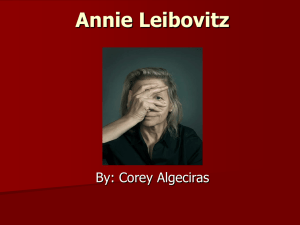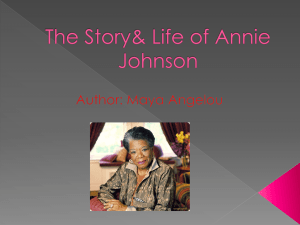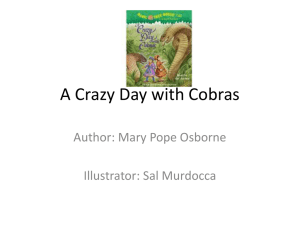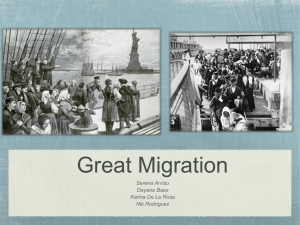Frontier Woman – Annie P.
advertisement
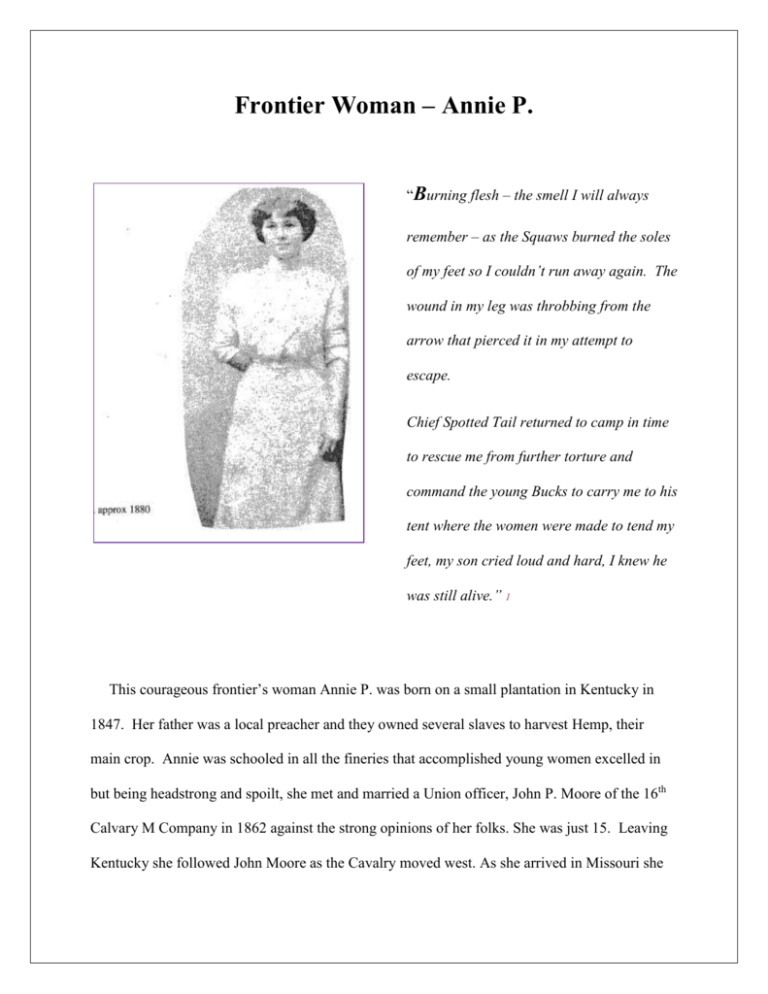
Frontier Woman – Annie P. “Burning flesh – the smell I will always remember – as the Squaws burned the soles of my feet so I couldn’t run away again. The wound in my leg was throbbing from the arrow that pierced it in my attempt to escape. Chief Spotted Tail returned to camp in time to rescue me from further torture and command the young Bucks to carry me to his tent where the women were made to tend my feet, my son cried loud and hard, I knew he was still alive.” 1 This courageous frontier’s woman Annie P. was born on a small plantation in Kentucky in 1847. Her father was a local preacher and they owned several slaves to harvest Hemp, their main crop. Annie was schooled in all the fineries that accomplished young women excelled in but being headstrong and spoilt, she met and married a Union officer, John P. Moore of the 16th Calvary M Company in 1862 against the strong opinions of her folks. She was just 15. Leaving Kentucky she followed John Moore as the Cavalry moved west. As she arrived in Missouri she went to stay with John’s cousin John Harvey Moore. At the time, John Harvey Moore’s neighbors were quite notorious since they hailed by the names of Jesse & Frank James. As her husband’s Cavalry moved into the newly organized state of Colorado, Annie arrived in Silverton Colorado to make a home for them. Just a month short of her only child, John Augusta Moore’s birth, her husband was killed in a skirmish with the Confederate Army at the Battle of Little Blue Oct, 1863. 2 After a few months gold was discovered over in Golden City and the miners, and people who wanted to cash in on the mining booms- from town to town- and- state to state- moved on. This is what brought Annie and her nine-month old son into Indian Country and imminent danger. As the wagon train was making its way to the new Gold strike they were attacked by a war party led by the Sioux Chief Spotted Tail fresh from a raid on the Julesburg Stage Stop in Colorado. The Sioux were much feared in the Colorado Territory for their brutality in war. The men of the wagon train unhooked the horses from the wagons and hoisted Annie Chief Spotted Tail approx. 1880 - Colorado and her baby up onto a horse and slapped its rear. Annie took off running, but not fast enough, an arrow pierced her leg as the horse went lame. Many of the men from the wagon train were tortured and put to death, but Annie stated she believed it was because she showed no fear the Indians spared her and John’s lives. Quoting from her journal about some of what she endured, Annie P wrote, “Burning flesh – the smell I will always remember – as the Squaws burned the soles of my feet so I couldn’t run away again. The wound in my leg was throbbing from the arrow that pierced it in my attempt to escape. Chief Spotted Tail returned to camp in time to rescue me from further torture and command the young Bucks to carry me to his tent where the women were made to tend my feet, my son cried loud and hard, I knew he was still alive.” 1 It was several weeks before Annie’s feet healed and she could hobble around the camp, always under the suspicious watch of one of the Indian women. One morning Annie was told to go and fetch water for the morning meal. This particular morning Annie was wary that no watcher accompanied her, but they had her baby, where would she go? As she bent down to fill the earthen jugs with cool water she saw the woman guard raise a long knife directly behind her. Quickly turning she fought and wrestled with the woman, finally wrenching the knife from the woman’s hand. The woman pled for Annie not to kill her, but Annie assured her she just wanted to escape. This was a surprise to the woman and she promised Annie if would spare her life, the woman would assist in helping Annie and her son escape. It was many days later on a night with no moon that Annie heard the slight sound by her buffalo robe and turned to see the Indian woman motioning her to crawl thru the cut in the side of the tent. Annie quietly took baby John and placing a hand over his mouth in case he stirred she tied him to her in his wrap and crawled out into the night. The Indian woman walked lightly thru the camp and past the sleeping dogs into the rocks and boulders. Annie followed hoping that this was not another trap to kill her. On guard she followed the ghostly figure until they were far from camp. Using sign language and some broken English and Sioux, the woman instructed Annie to travel only at night and hide during the day or she would be captured and killed. Giving her a packet of food and a small jug of water, the woman faded out of her life. Annie continued on in the direction the woman told her to travel, and as the sun started to rise she hid in a small cave she stumbled onto. She could look down into the valley from her hiding place and it didn’t take too much waiting to see the band of Indians galloping across the sagebrush. If she had been frantic to escape and not found cover, she knew she would be dead. Two days out, she saw dust in the distance and some gleams of light dancing across the valley. Hopeful she hurried towards the dust praying for rescue. Out of food and water, it was her only chance. She hid in the sagebrush close to the trail and again covered the baby’s mouth to keep him quiet. Relief was so great she just sobbed, for there in the front of the dusty blue coats of the Union Army was a man she recognized from her husband’s unit. Waving her arms and calling in English she was able to stop the patrol and was immediately given water and food. One of the sergeants gave her a horse to ride as they continued to the fort at a faster pace than before. She and little John were safe. 3 In youth, widowhood, in captivity, in life, her strength, her capacity to stand strong in the face of insurmountable odds makes her one of the great unsung women of the frontier. Works Cited 1 - Jolley, Vera Moore, Life Story of Annie P. Simpson, Stevenson Genealogy Center, Provo, Utah 1989, Print. 2 - Kansas Adjutant General’s Report, 1861-1865, Sept. 2010, www.kshs.org/genealogists/ military/recscivil.html 3 - Carter, Kate, Heartthrobs of the West, Daughters of the Utah Pioneers, Salt Lake City, Utah 1940, Print. Photos Used Moore, Annie P., Moore Family Photos, 1989 Tail, Chief Spotted, Sept. 2010. www.firstpeople.us/FP-Html-Wisdom/SpottedTail.html Merlene Cook English 2010 Draft - Frontier Woman “Burning flesh – the smell I will always remember – as the Squaws burned the soles of my feet so I couldn’t run away again. The wound in my leg was throbbing from the arrow that pierced it in my attempt to escape. Chief Spotted Tail returned to camp in time to rescue me from further torture and command the young Bucks to carry me to his tent where the women were made to tend my feet, my son cried loud and hard, I knew he was still alive.” This courageous frontier’s woman Annie P was born on a small plantation in Kentucky in 1847. Her father was a local preacher and they owned several slaves to harvest hemp, their main crop. Annie was schooled in all the fineries that accomplished young women excelled in; sewing, singing, learning to manage a household, but her schooling also appealed to her excellent reasoning skills, because she also excelled in Mathematics which she would enjoy throughout her life. Headstrong and spoilt, she met and married a Union officer, John P. Moore of the 16th Calvary M Company in 1862 against the strong opinions of her folks. She was just 15. Leaving Kentucky she followed John Moore as the Cavalry moved west. As she arrived in Missouri she went to stay with John’s cousin John Harvey Moore. At the time, John Harvey Moore’s neighbors were quite notorious since they hailed by the names of Jesse & Frank James. As her husband’s Cavalry moved into the newly organized state of Colorado, Annie arrived in Silverton Colorado to make a home for them. Just a month short of her only child, John Augusta Moore’s birth, her husband was killed in a skirmish with the Confederate Army at the Battle of Little Blue Oct, 1863. John Augusta Moore was born on Nov 14, 1863 just 3 days shy of Annie’s 16th birthday. A war widow and alone, she found a friend in the Bakers who ran the boarding house in Silverton, Colorado. There was very little work but Annie thru her determination and sheer will power was able to support her and her new baby as the town became a boom town for Silver during the 1860s. During this time, she used her sewing skills to be a seamstress and cook for the Bakers. She also learned the skill of running a boarding house which she continued to use until her death. After a few months gold was discovered over in Golden City and the miners, and people who wanted to cash in on the mining booms from town to town and state to state moved on. This is what brought Annie and her nine month old son into Indian Country and imminent danger. As the wagon train was making its way to the new gold strike they were attacked by a war party led by the Sioux Chief Spotted Tail fresh from a raid on the Julesburg Stage Stop in Colorado. The men unhooked the horses from the wagons and hoisted Annie and her baby up onto a horse and slapped its rear. Annie took off running, but not fast enough, an arrow pierced her leg as the horse went lame. Many of the wagon train were tortured and put to death, but Annie stated she believed it was because she showed no fear the Indians spared her and John’s lives. She was able to escape after spending many months in captivity with the help of an Indian woman who wanted her gone. In 1865 she left Colorado and arrived in Utah driving her own team and horses headed to another Gold strike and the promise of a brighter future. She always had money which puzzled the people who knew her. She always bought land and opened a boarding house whatever town in whatever state or territory she lived. It was important for her to have roots deep in the Earth. Her parents disowned her when she married a Union soldier and even many years later her letters to her folks back east came back unopened…some after several months. In youth, widowhood, in captivity, in life, her strength, her capacity to stand strong in the face of insurmountable odds makes her one of the great unsung women of the frontier. From green valleys of Kentucky to the parched mountain deserts of Utah she was an example that women can do anything they need to do to adjust to their current environment and overcome, .No obstacle too difficult, no trip so long, or adversity so black that you cannot overcome and not only survive, but thrive. Even in the last years of her life she traveled many hundreds of miles alone to be with those she loved. Dying as she lived, in a small mining town in Salmon Idaho in a boardinghouse she owned with just her friend and husband by her side. Might I have the courage to overcome the adversities in my life which are not as physical as hers were, and weather life as she did with courage, fortitude and honor. Annie P. was a 19th century woman who showed this 21st century woman how to survive and thrive in the face of unknown obstacles leaving a legacy of love to children, grand children and many generations to come. Re:Profile and Topic: Week Five: Peer Review Review Questions Author: Sherri Date: September 24, 2010 11:07 PM Bohne I got that this profile is about a pioneer women who went through some tough trials. The profile seems to be written for those who want to learn more about women pioneer. The audience would probably be older people who are interested in true history. I believe all the passages were clear and descriptive. The only place it could possibly use more clarity is tying the ending more with the beginning as far as saying something about brave, historical women etc. etc. A picture added would be great if you could find one, just to know what she looked like after the great descriptive profile! Sherri Bohne Merlene, What a great story. I really enjoyed reading about Annie. The way you tell the story clearly shows her courage. The opening and closing sections of the essay still feel a bit general. I would recommend focusing just on this story and what it conveys about Annie. For instance, it's certainly interesting that a 19th century woman was interested in mathematics, but this detail doesn't connect to the story of her captivity. I'm sure there are many stories you could tell about Annie, but focus on just this story. The design elements you incorporated helped the text to be very readable and the pictures help the reader to envision Annie's life. The one thing you might work on is the big chunk of white space on the top right of page one. Rather than leaving the space blank, you might want to use this for the quote from her life story. This quote along with the picture will give your reader a strong introduction to your topic. Another thing to work on is the citations. You've included citations in small italics after the paragraph. Incorporating the full citation probably makes more sense here than using the parenthetical strategy of MLA. But, having so much citation detail right in the text is a bit distracting. You may want to consider incorporating footnotes or endnotes as they are often less intrusive. Great job on this first assignment. Thanks for your good work. Let me know if you have any questions about my comments. best, Melissa


